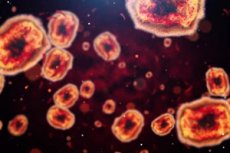New publications
Boys are more likely to be cured of HIV after intrauterine infection
Last reviewed: 02.07.2025

All iLive content is medically reviewed or fact checked to ensure as much factual accuracy as possible.
We have strict sourcing guidelines and only link to reputable media sites, academic research institutions and, whenever possible, medically peer reviewed studies. Note that the numbers in parentheses ([1], [2], etc.) are clickable links to these studies.
If you feel that any of our content is inaccurate, out-of-date, or otherwise questionable, please select it and press Ctrl + Enter.

Baby girls are more likely to become infected with HIV from their mothers during pregnancy or birth than baby boys, who are more likely to achieve a cure or remission, researchers say in a new study highlighting gender differences in the immune system.
The World Health Organization estimates that about 1.3 million women and girls living with HIV become pregnant each year, and the rate of transmission of the virus to the baby during pregnancy, childbirth or breastfeeding, in the absence of any intervention, ranges from 15 to 45 percent.
Lead researcher Philip Goulder says the study has identified some key mechanisms by which sustained HIV remission can be achieved - mechanisms that are relevant for both children and adults.
Goulder and colleagues assessed 284 infants in KwaZulu-Natal, South Africa, one of the regions with the highest HIV prevalence in the world, who were started on combination antiretroviral therapy (cART) from birth after being exposed to HIV during pregnancy.
"We found that transmission of HIV to male foetuses was 50 per cent less common than to female foetuses," says Goulder, professor of immunology in the department of paediatrics at the University of Oxford in the UK.
"The infected boys had lower levels of virus in their blood, and to date, four boys in this study have achieved HIV cure/remission – meaning they have undetectable levels of HIV in their blood even without treatment," he said.
HIV cure is divided into "true cure," in which the virus is completely eliminated from the body, and "functional cure" or "remission," in which the virus is no longer detectable in the blood even after treatment is stopped.
Goulder said the difference found between male and female babies is likely due to lower levels of activated CD4 T cells in male fetuses compared to females, which makes it more difficult for the virus to establish a reservoir and provide a barrier against infection.
"If by chance the virus is transmitted to a man, he struggles to survive because there are not enough activated CD4 T cells to sustain the infection," he added.
CD4 T cells are a type of white blood cell that helps the body fight infections like HIV. They are an important part of the immune system and are the target of HIV when it infects you. HIV spreads more slowly when CD4 T cell levels are low.
The study, published last month in the open access journal Nature Medicine, adds to existing knowledge about HIV cure/remission and may have implications for cure strategies aimed not just at children, but at all 39 million people living with HIV worldwide, according to the researchers.
"This is a breakthrough achievement for South Africa, where almost eight million people are living with HIV," said Nomonde Bengu, a co-author of the study from the Queen Nandi Regional Hospital in KwaZulu-Natal.
The study has been ongoing since 2015 and includes 30 infants per year, with 315 participants so far.
"This is probably the largest cohort of its kind in the world," Bengu said.
"We study and track not only children living with HIV, but also their mothers."
Access to mother and baby at the time of birth, when HIV can be diagnosed, allowed researchers to study the specific virus that was transmitted, the so-called "core virus," Bengu noted.
"This is an extremely valuable resource for understanding the mechanisms of cure/remission in children who then achieve it," she added.
However, the researchers note that some male infants still have very low levels of HIV antibodies in their blood.
"The long-term effects on children are unknown," Goulder acknowledges.
"An African child similar to those in our study remained untreated with undetectable virus in the blood for 15 years, and it is possible that some children may remain without antiretroviral therapy for life."
The findings are consistent with what is known about HIV infection in adults, according to the researchers.
They add that the mechanisms by which HIV cure/remission can be achieved are potentially applicable to all 39 million people living with HIV.
The researchers acknowledge that the number of children who achieve cure/remission is small and further research is important.
But they say it's an improvement on previous studies that found only a few children who achieved cure/remission.
"This paper adds momentum and knowledge to efforts to control HIV through immune interventions," said Mark Cotton, an emeritus professor in the department of paediatrics and child health at Stellenbosch University in South Africa, who was not involved in the study.
"The study highlights one of the complexities - female infants are more likely to become infected with HIV. It also highlights the importance of studying children in HIV treatment and control research."
